駆逐艦
| アイコン | 意味 |
| 戦闘や事故で失った場合(沈没、墜落)や損傷した場合、艦船などの内部で事故や事件がおこった場合の意味です。自軍や同盟軍、所属機関、所有会社が行った沈没処分や破壊処分、漁礁としてまたは演習で使用して沈めた場合にはこのアイコンは付けません | |
| 戦果や功績、各機関に寄贈された場合の意味です。戦争などで沈没し、何十年後に発見された場合もこのアイコンです | |
| 映画やTVドラマ、ドキュメンタリーに使用された場合の意味です | |
| 参考文献、小説や書籍に登場する事柄です | |
| インターネットやTVゲームに登場する事柄です | |
| 不可解な事故&事件およびUFOなど超常現象に遭遇した事柄です |
- 軽荷排水量:5,826t 満載排水量:8,040t 全長:171.70m 幅:16.80m 吃水:5.80m(ソナー部5.80m) 主機/軸数:COGAG(ジェネラル・エレクトリック式LM2500ガス・タービン4基)/2軸 出力:86,000馬力 速力(計画):33.0kt 燃料搭載量:軽油1,400t 航続力(計画):20ktで6,000浬 兵装:トマホークSLCM/アスロックSUM用VLS1基61セル、ハープーンSSM4連装発射機2基、シー・スパロー短SAM8連装発射機1基、RAM近接防御SAM21連装発射機1基(逐次装備中)、54口径127mm単装両用砲2基、25mm単装機関砲1基〜2基、76口径20mmCIWS2基、12.7mm単装機銃4基、324mm3連装短魚雷発射管2基 搭載機:ヘリコプター2機 乗員:319名〜339名
- ※同級は、就役後に順次兵装を強化し、さらに1986年度に始まるオーヴァーホールを利用して近代化改装を実施
- ※1977年に計画し1978年度予算で2隻の建造が要求された対潜能力強化のヘリコプター駆逐艦計画。1隻の建造が認められたが(DDH-997)、予算を大きくオーヴァーしてしまい通常型の駆逐艦DD-997として建造された
- ※DD-968は、1997年〜1998年の改装で後檣をステルス性に優れたAEMS(Advanced Enclosed Sensor System)に改めた
- ※スプルーアンス(DD-963)の内部画像
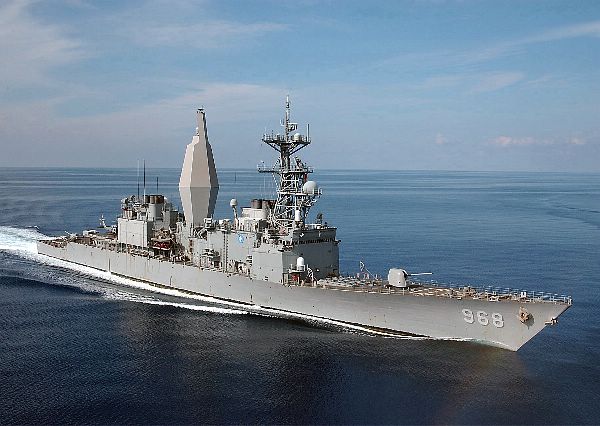
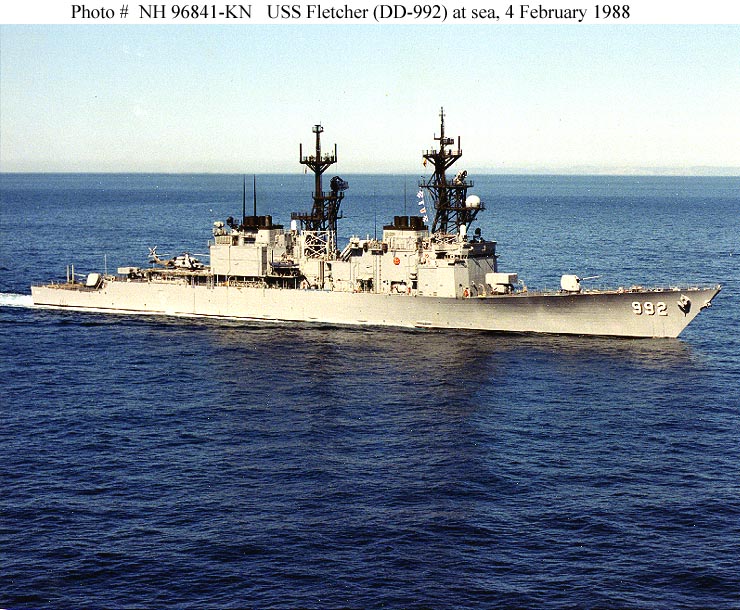
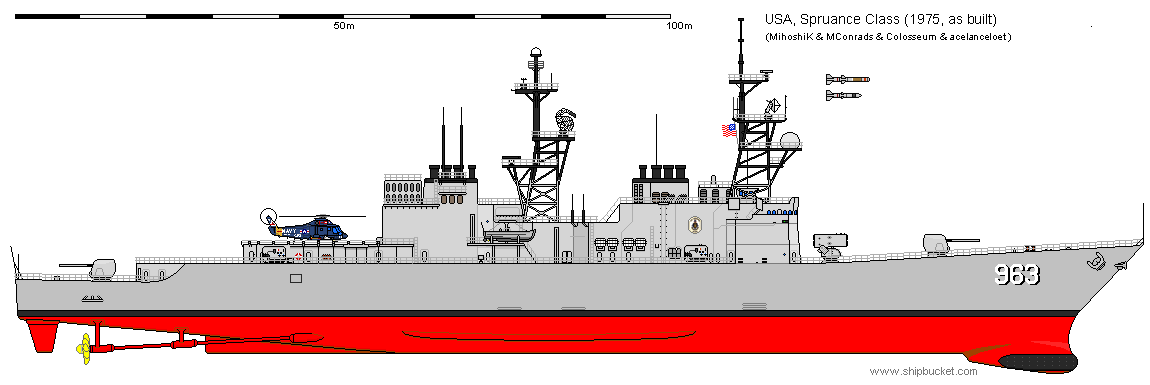


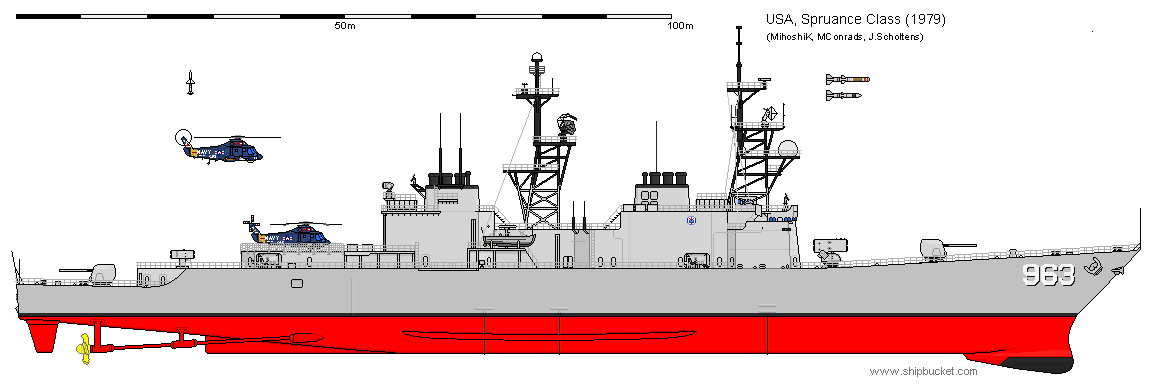
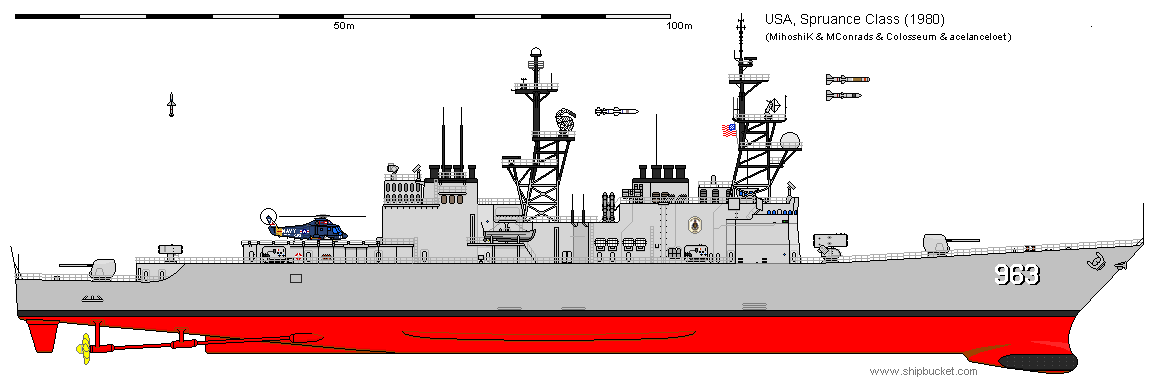

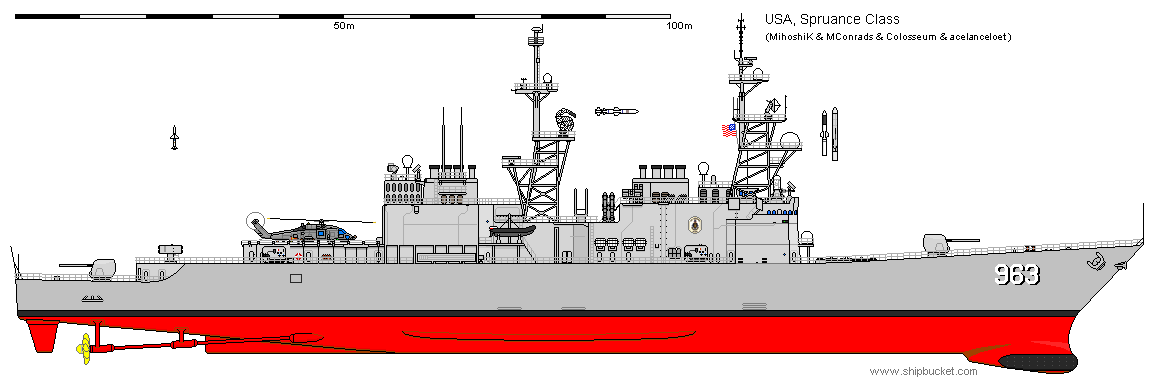
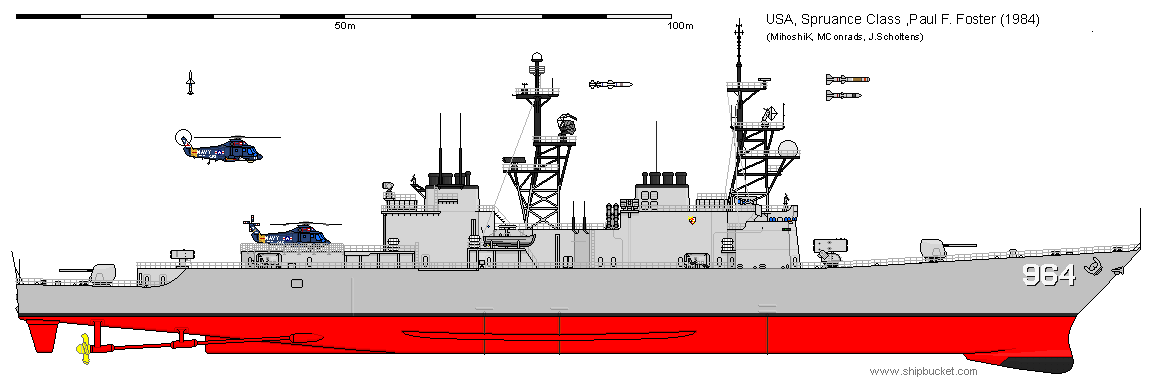
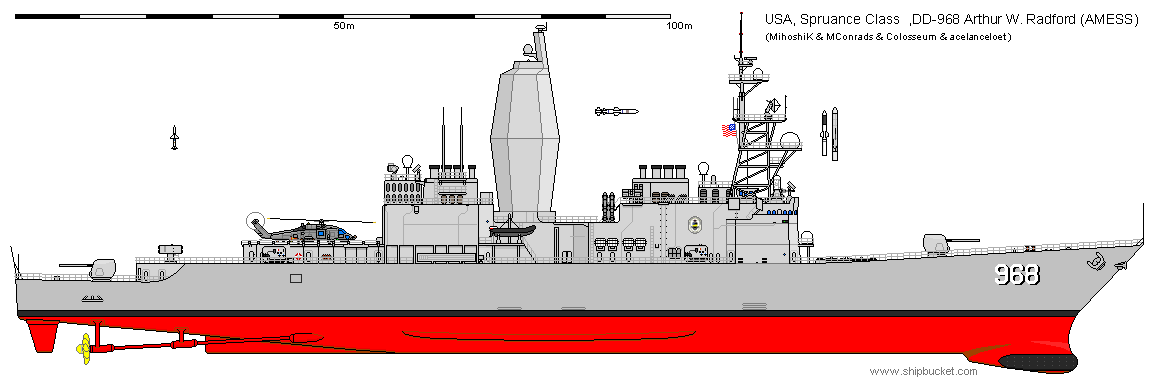
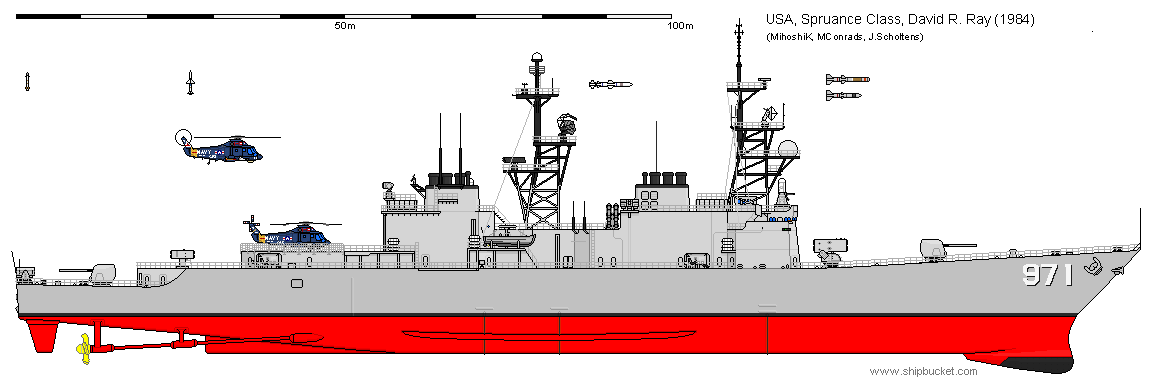
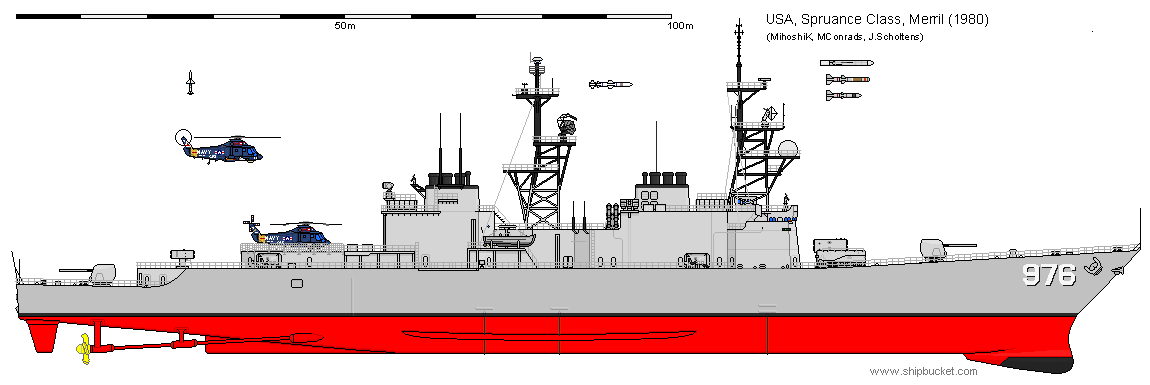

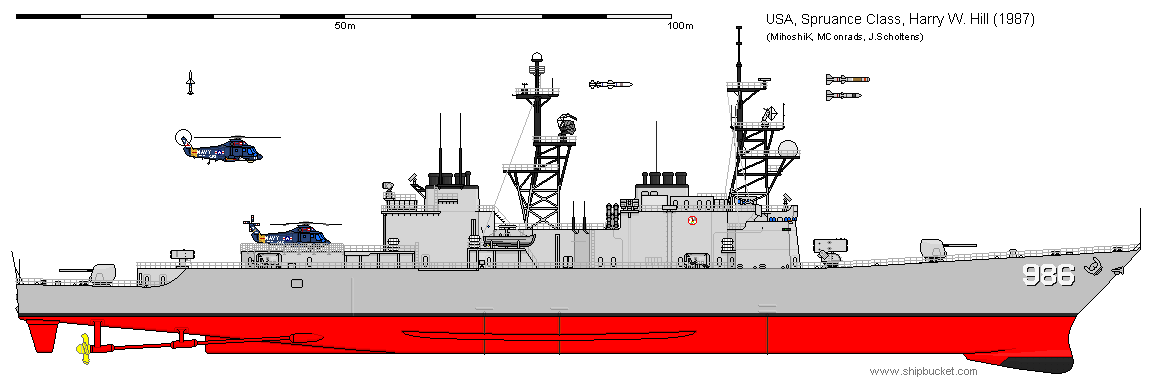
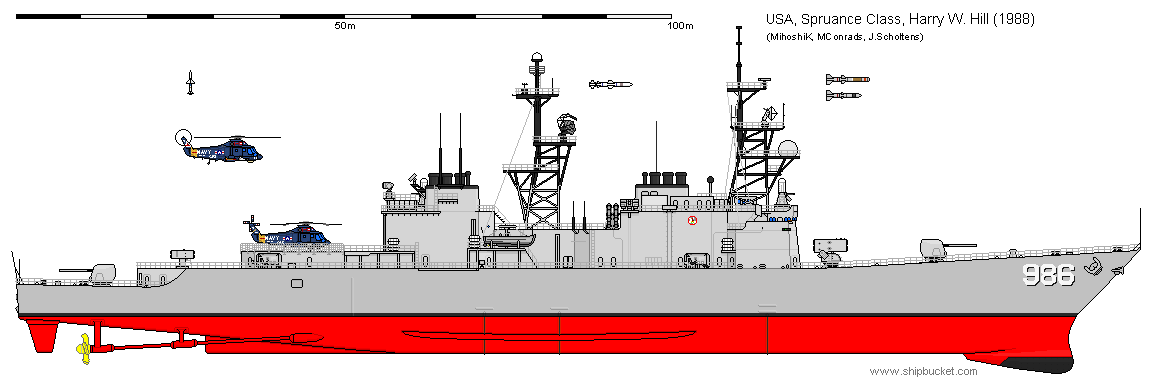
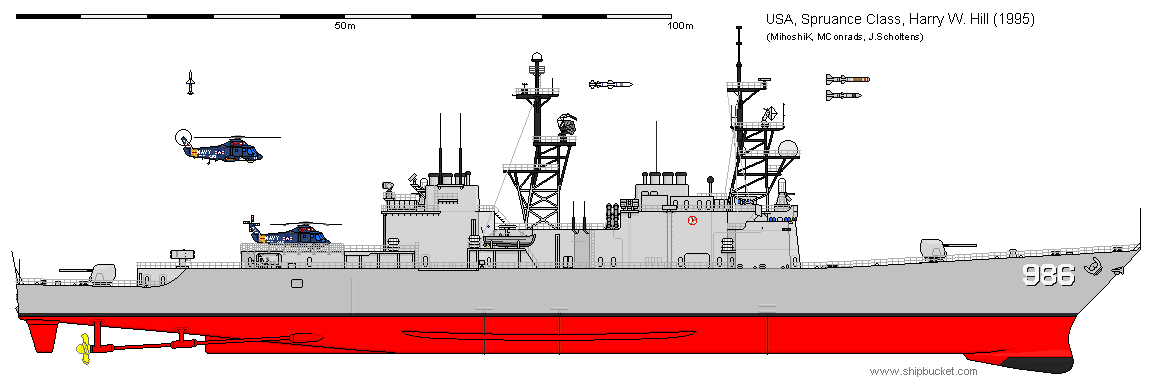
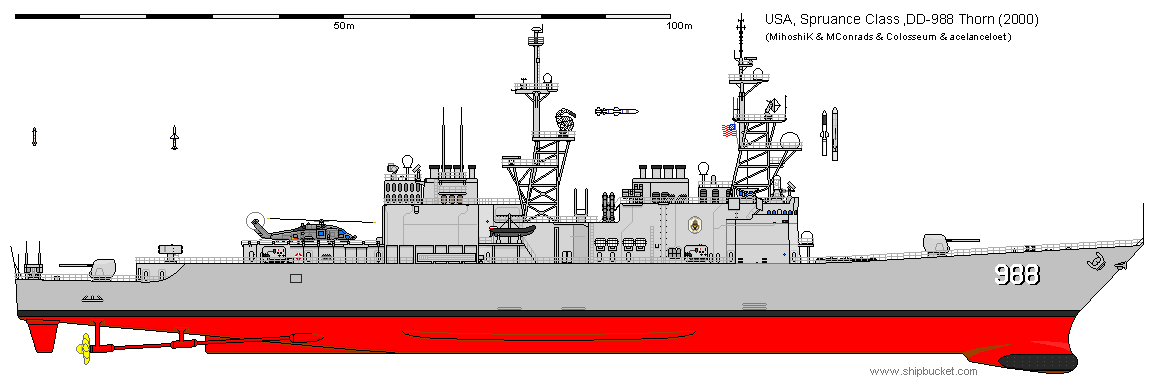
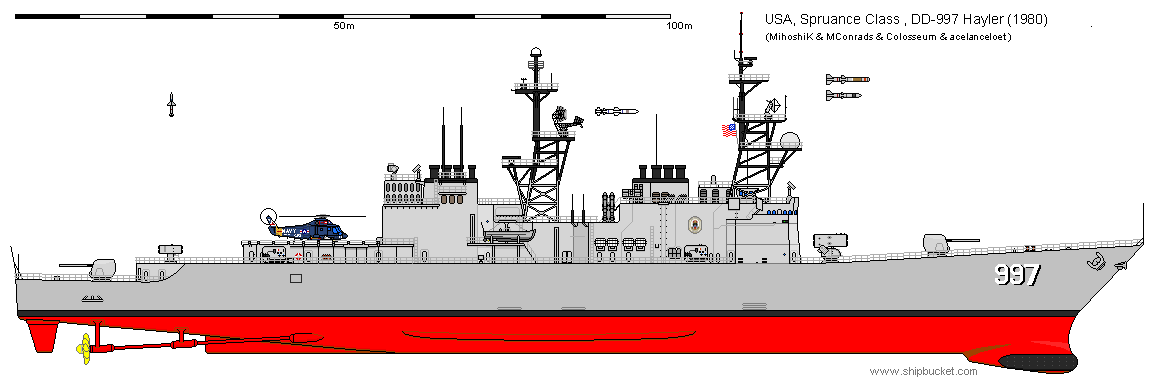
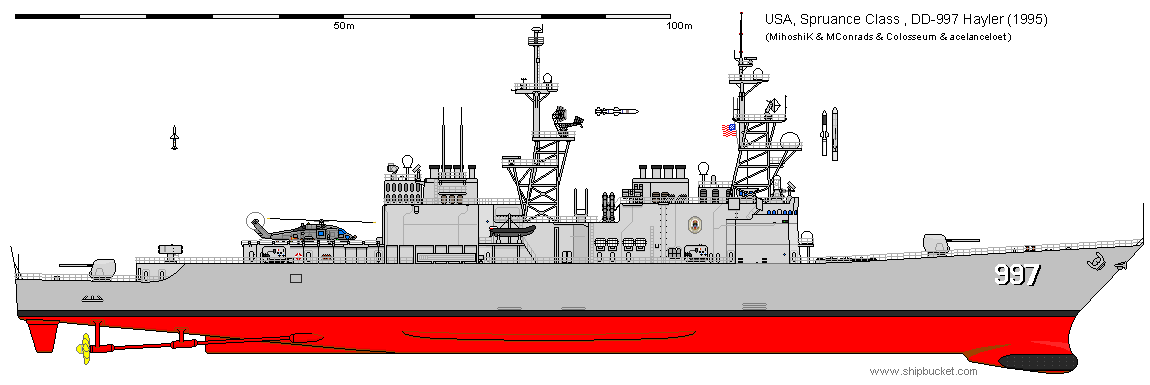
- ※リットン社は燃料消費と取得コストの観点から、30ktにおいて出力約20,000馬力のLM2500が3基で済む比較的長い船体を選択、巡航時はガス・タービン1基が電動継手によって両舷軸を回すという複雑なメカニズムを採用。この設計によって同社は競争に勝ったが、海軍は契約後に直ちに4基目のガス・タービンを追加して継手を廃止するように要求。同社が初めから80,000馬力で設計していたら、DXの寸法は短い艦になっていたといわれる。下の画像は、オリジナルの巡航時はガス・タービン1基が電動継手によって両舷軸を回すという複雑なメカニズムのヴァージョンの画像
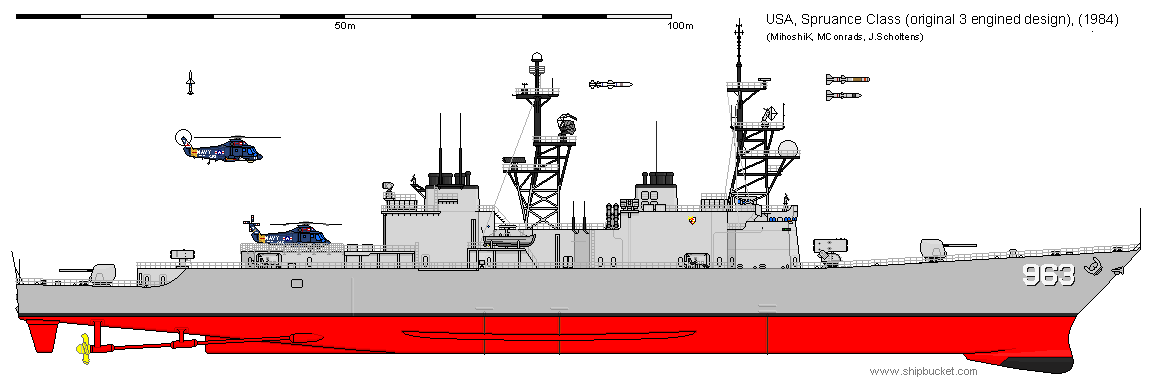
- ※下の画像2枚は、DXから将来へのDXGへの2段階の改造予定の変遷である。最初は、アスロック発射機と54口径127mm単装両用砲1基をターターSAM/アスロックSUM兼用発射機(Mk. 22)と交換するだけで次期原子力ミサイル駆逐艦(DDGN)と大体同じ物と考えられていた。実際はターターSAM、ハープーンSSM、アスロックSUM兼用のMk. 26を装備。最終的に前部のアスロックSUM発射機をMk. 26 Mod. 0に、シー・スパロー短SAM発射機に代えてMod. 1を後部に設置。前部を203mmMk. 71単装軽量自動砲に換装を予定していた
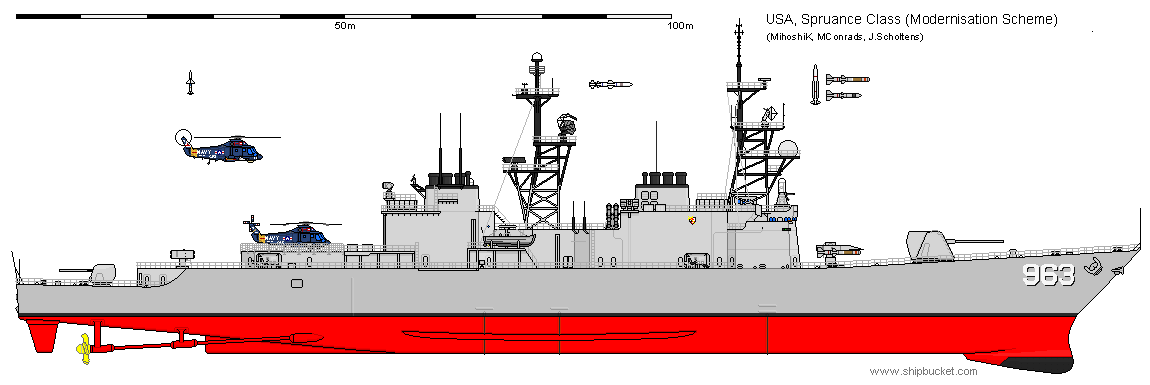
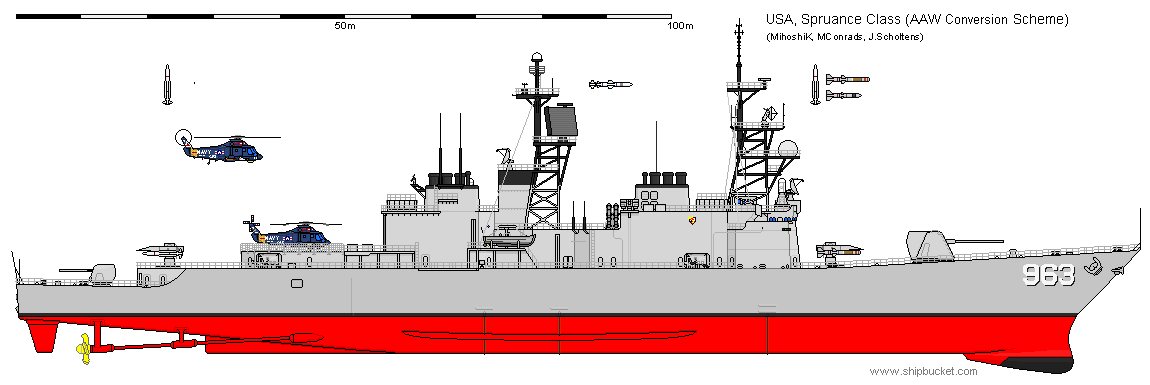

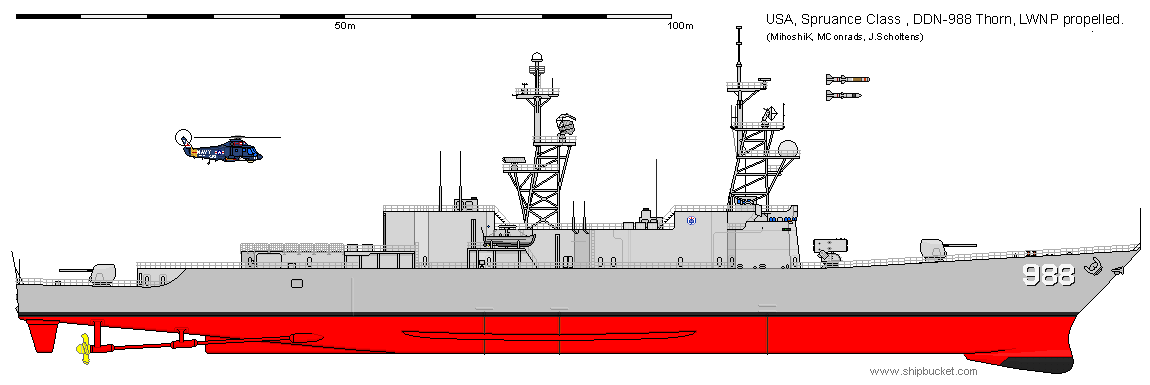
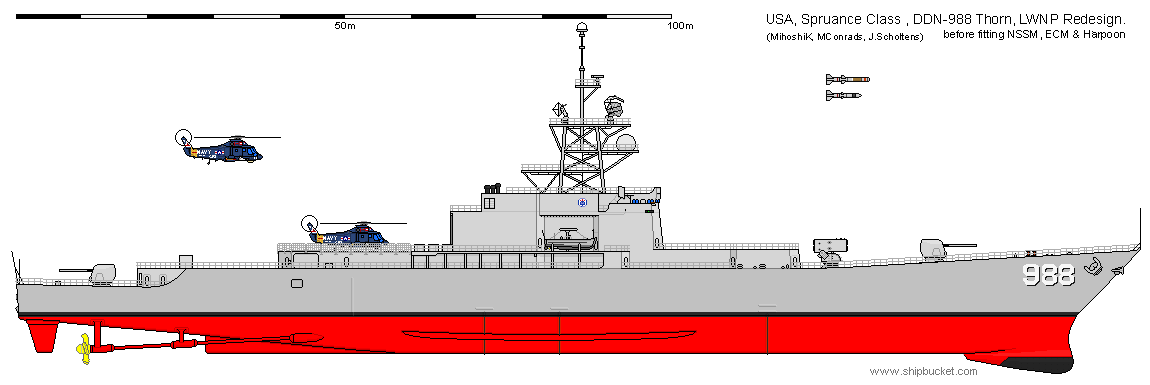
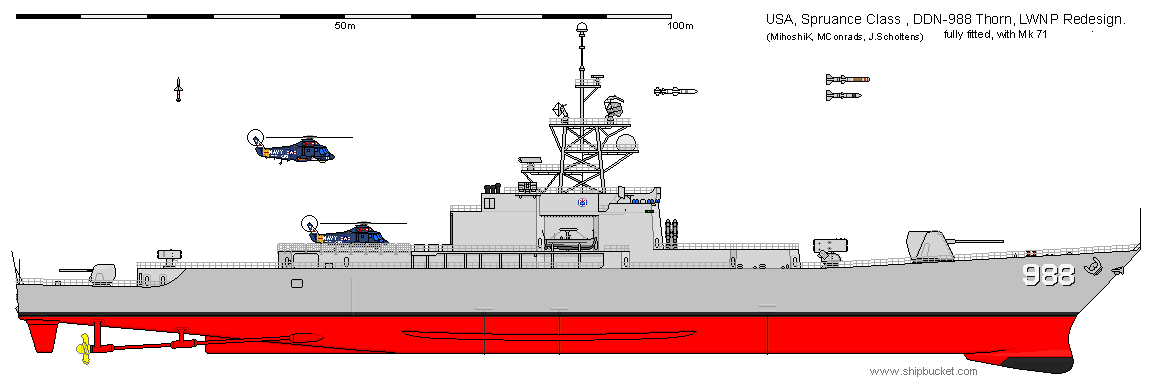
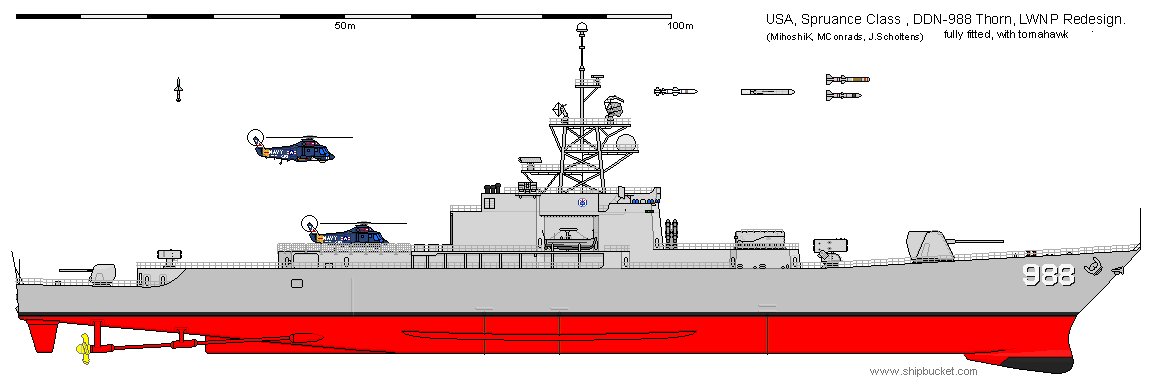
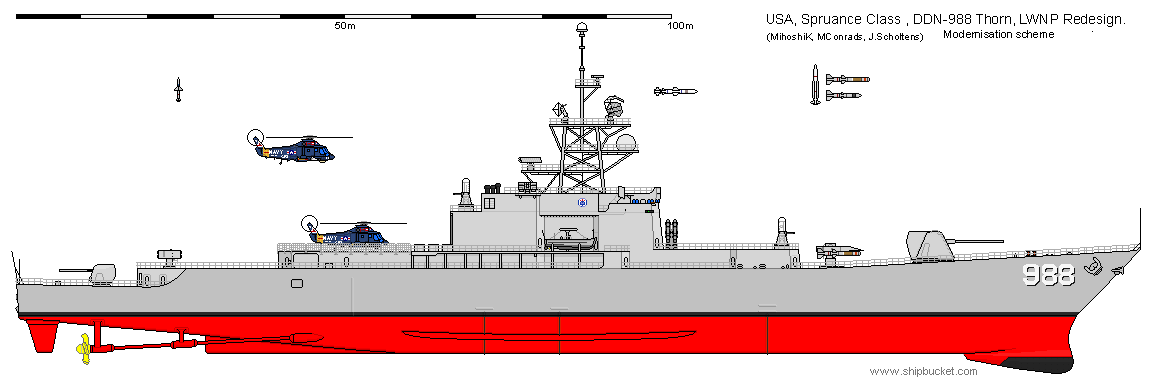
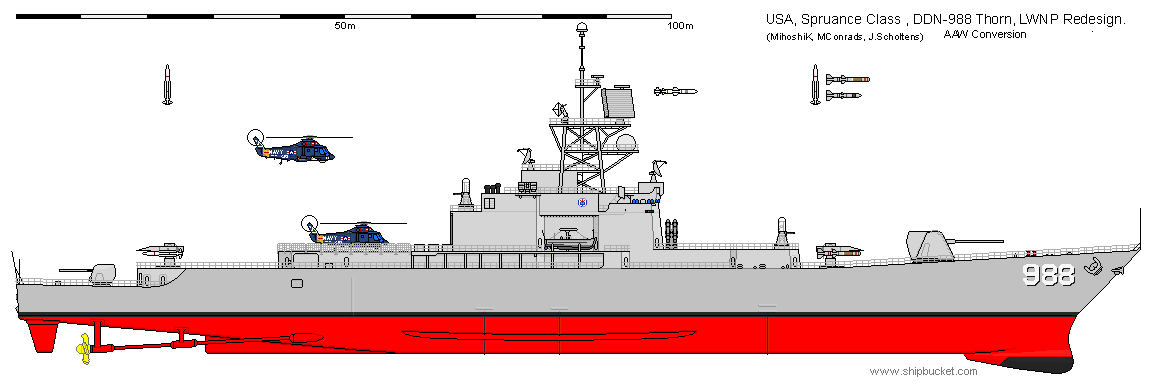
- ※1970年代中期に、同級の船体を利用した数十機のSTOVL機の運用を図らんとした航空能力艦ACS(Air Capable Ship)計画等があった
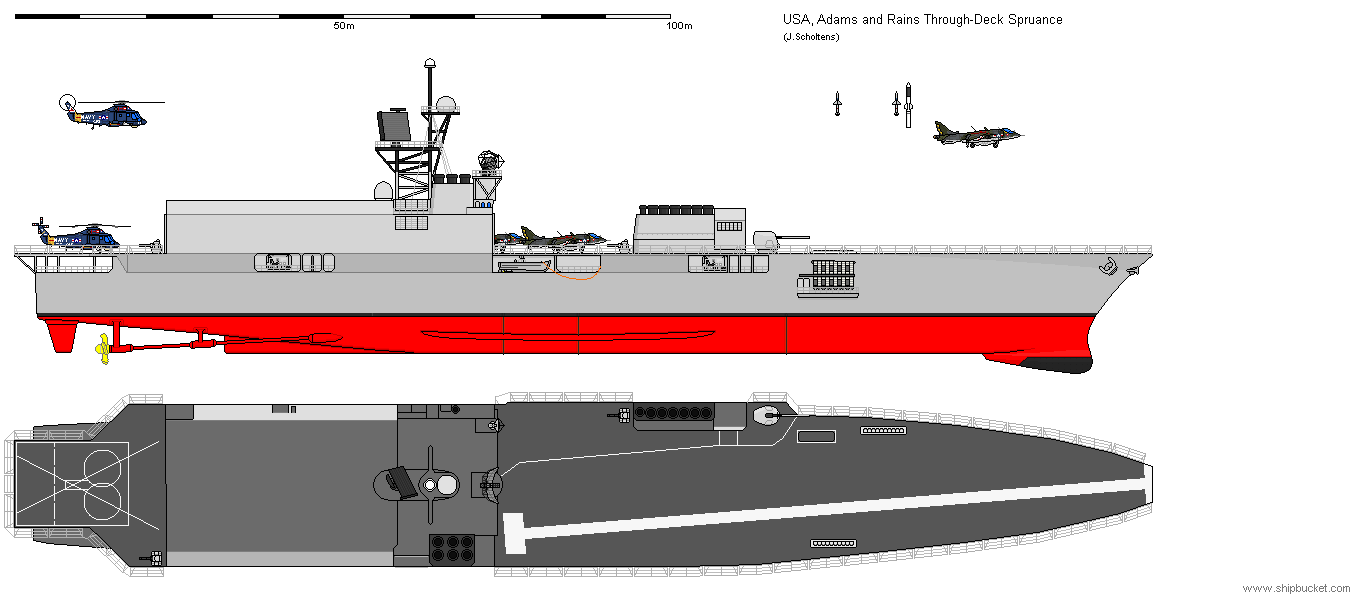
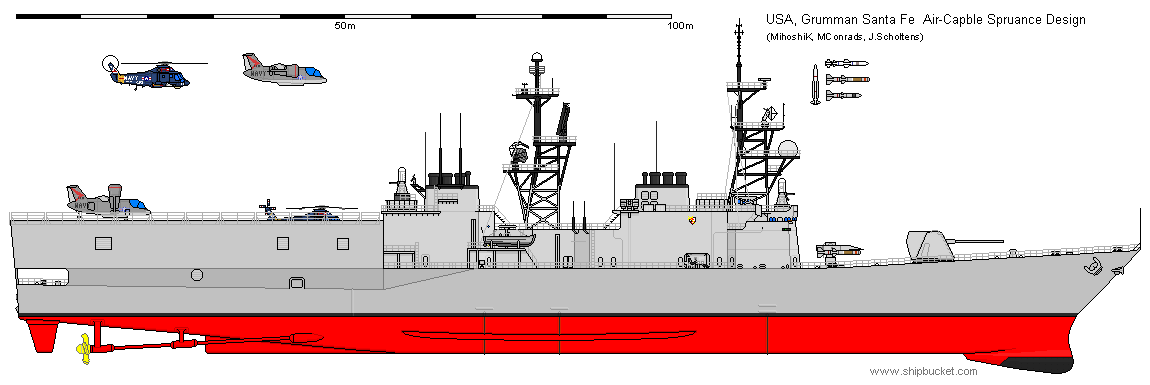
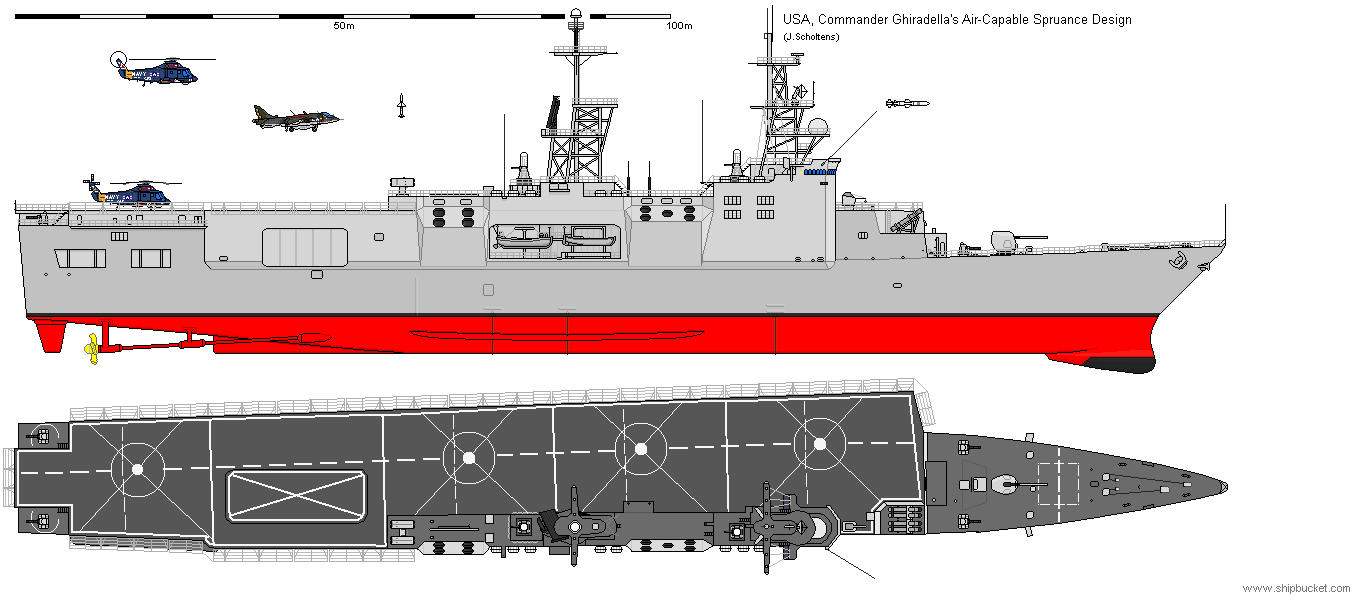
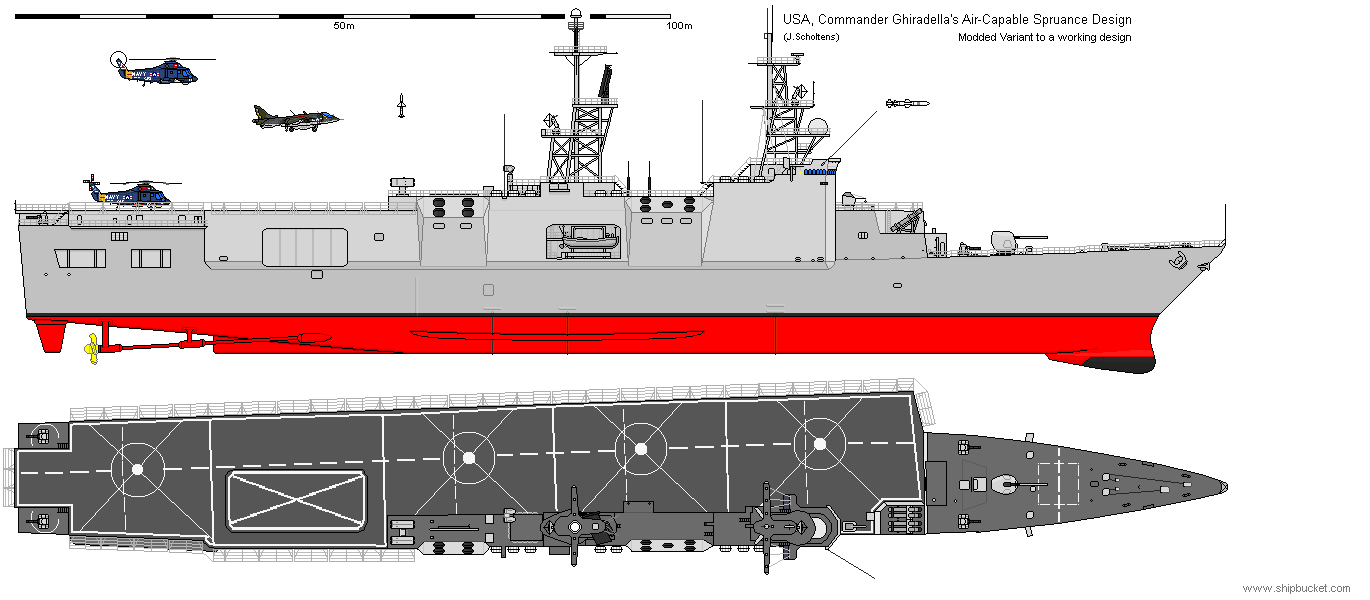
- ※1977年度予算で前部127mm単装両用砲を、203mmMk. 71単装軽量自動砲に換装して火力支援艦にする計画(議会の承認を得られなかった)
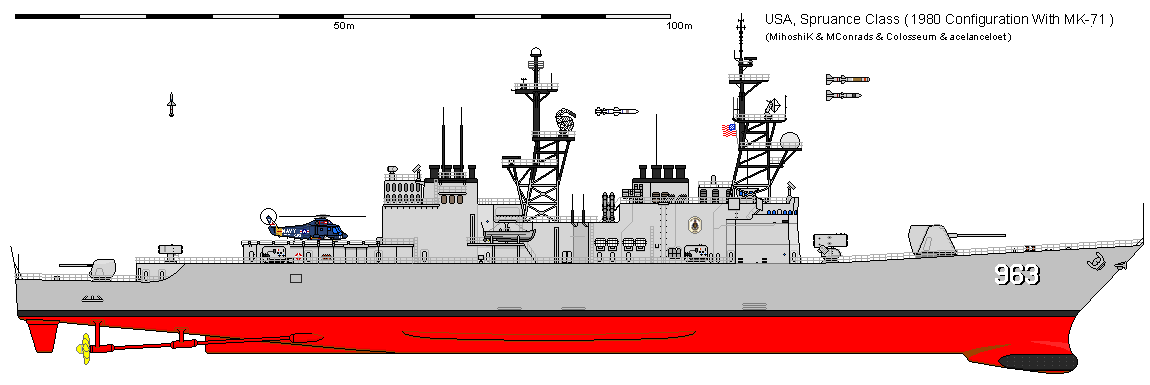
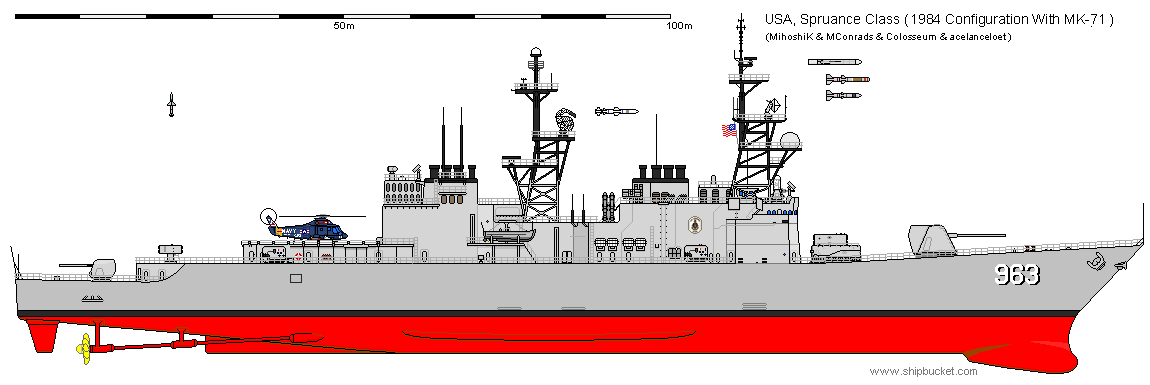
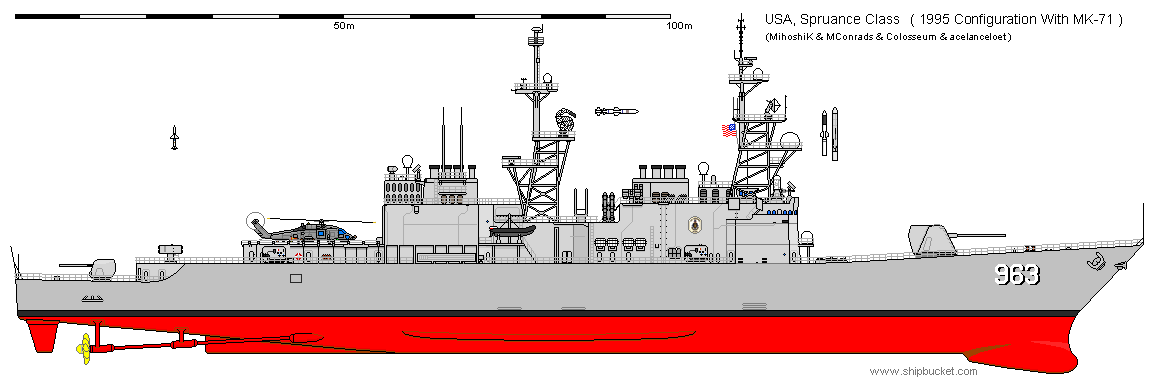
- ※127mm単装両用砲を、62口径155mm先進艦載砲システム(AGS)に換装して火力支援艦にする計画
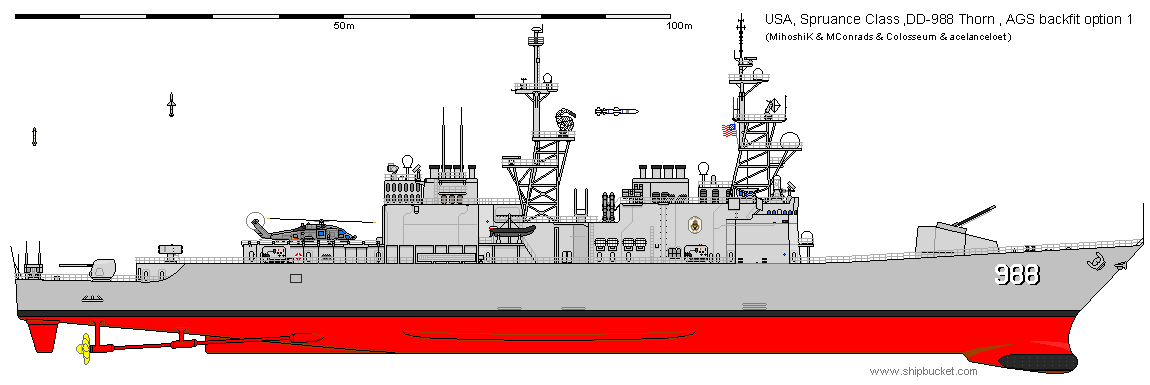
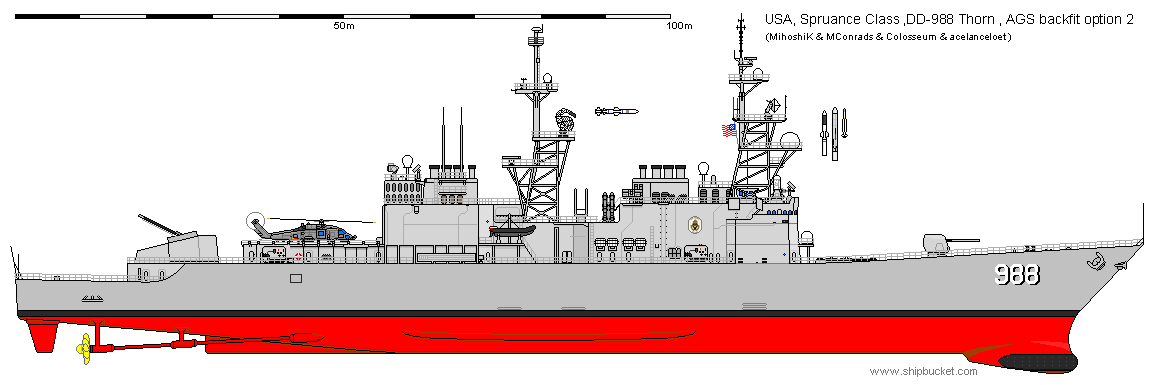
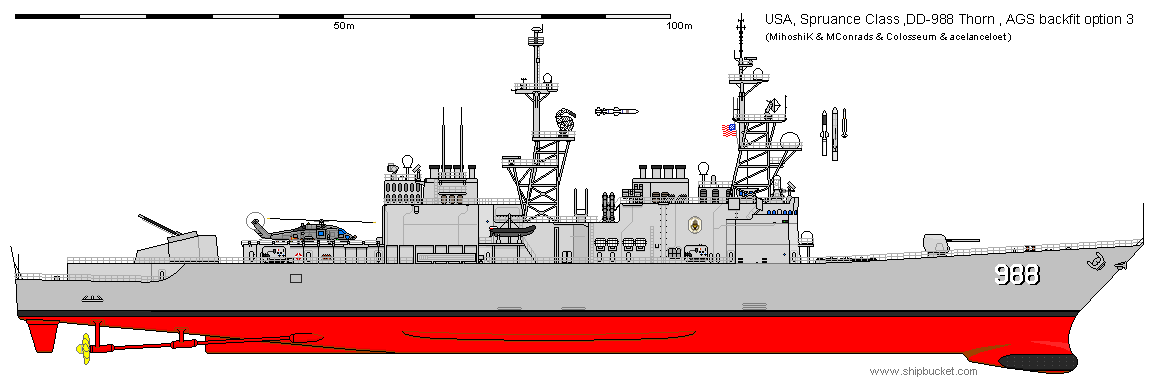
| 艦名 | NAME | 艦種記号 | 建造所 | 就役日 | 退役日 | 除籍日 | 備考 |
| スプルーアンス (1、2) |
Spruance | DD-963 | インガルス造船所 | 1975/9/20 | 2005/3/23 | ◎1972/11/27 起工 ◎1973/11/10 進水 ◎1975/8/12 引き渡される ◎2006/12/7〜8 Sinkex演習に、標的として沈没 |
|
| ポール F. フォスター | Paul F. Foster | DD-964 | インガルス造船所 | 1976/2/21 | 2003/3/14 | 2004/4/6 | ◎1973/2/6 起工 ◎1974/2/22 進水 ◎2003/3/27 Naval Surface Warfare CenterのPort Hueneme DivisionにてSelf Defense Test Ship (SDTS)となる ◎2005/3/16 艦種を実験駆逐艦(EDD-964)に改める |
| キンケイド | Kinkaid | DD-965 | インガルス造船所 | 1976/7/10 | 2003/1/7 (1、2) |
2004/4/6 | ◎1973/4/19 起工 ◎1974/5/25 進水 ◎1990初めころ スービック湾の中型浮きドック(非自走)リソースフル Resourceful(AFDM-5)にて入渠、修理(1、2) ◎2004/7/14 Sinkex演習に、第14空母航空団(CVW-14)の標的として沈没 |
| ヒューイット | Hewitt | DD-966 | インガルス造船所 | 1976/9/25 | 2001/7/19 | 2002/6/5 | ◎1973/7/23 起工 ◎1974/8/24 進水 ◎除籍後、解体のため、BrownsvilleのInternational Shipbreakersに売却 |
| エリオット | Elliott | DD-967 | インガルス造船所 | 1976/1/22 | 2003/12/2 | 2004/4/6 | ◎1973/10/15 起工 ◎1974/12/19 進水 ◎除籍後、真珠湾にてNaval Inactive Ship Maintenance Facility(NISMF)により保管 ◎2005/7/23 珊瑚海にて標的として沈没 |
| アーサー W. ラドフォード | Arthur W. Radford | DD-968 | インガルス造船所 | 1977/4/16 | 2003/3/18 | 2004/4/6 | ◎1974/1/24 起工 ◎1975/3/1 進水 ◎1986/5/30 ノーフォークにて修理(〜1986/6/17) ◎除籍後、ノースロップ・グラマン・シップ・システムズに貸与され次世代駆逐艦 DD(X)の試験艦に改装(〜2005) ◎2011/8/10 デラウェア州沖にて人工環礁のため沈没処分(1、2、3、4、5、6、7、8、9、10、11) |
| ピーターソン | Peterson | DD-969 | インガルス造船所 | 1977/7/9 | 2001/10/4 | 2002/11/6 | ◎1974/4/29 起工 ◎1975/6/21 進水 ◎2004/2/16 次世代駆逐艦 DD(X)搭載用兵器テストにより標的として沈没 |
| カロン | Caron | DD-970 | インガルス造船所 | 1977/10/1 | 2001/10/15 | 2002/6/5 | ◎1974/7/1 起工 ◎1975/6/24 進水 ◎2002/12/4 プエルト・リコ沖にて爆発テストにより沈没(1、2、3、4) |
| デイヴィッド R. レイ | David R. Ray | DD-971 | インガルス造船所 | 1977/11/19 | 2002/2/28 | 2002/11/6 | ◎1974/9/23 起工 ◎1975/8/23 進水 ◎退役後、ブレマートンにてNaval Inactive Ship Maintenance Facility(NISMF)によりカテゴリー“C”保管 |
| オルデンドルフ | Oldendorf | DD-972 | インガルス造船所 | 1978/3/4 | 2003/6/20 | 2004/4/6 | ◎1974/12/27 起工 ◎1975/10/21 進水 ◎除籍後、真珠湾にてNaval Inactive Ship Maintenance Facility(NISMF)により保管 ◎2005/8/25 ハワイ沖にて標的として沈没 |
| ジョン・ヤング | John Young | DD-973 | インガルス造船所 | 1978/5/20 | 2002/9/19 | 2002/11/6 | ◎1975/2/17 起工 ◎1976/2/7 進水 ◎2004/4/13 Sinkex 2004演習に、原子力攻撃型潜水艦パサデナ Pasadena(SSN-752)の標的として沈没(1、2、3、4、5、6、7、8、9、10、11) |
| コムト・ド・グラース | Comte de Grasse | DD-974 | インガルス造船所 | 1978/8/5 | 1998/6/5 | 1998/6/5 | ◎1975/4/4 起工 ◎1976/3/26 進水 ◎除籍後、標的として沈没(1、2、3) |
| オブライエン (1、2) |
O'Brien | DD-975 | インガルス造船所 | 1977/12/3 | 2004/9/24 (1、2) |
◎1975/5/9 起工 ◎1976/7/8 進水 ◎2006/2/9 Sinkex 2006演習に、ミサイル巡洋艦レイク・エリー Lake Erie(CG-70)の標的として沈没 |
|
| メリル | Merrill | DD-976 | インガルス造船所 | 1978/3/11 | 1998/3/26 | 1998/3/26 | ◎1975/6/16 起工 ◎1976/9/1 進水 ◎2003/8/1 標的として沈没 |
| ブリスコー | Briscoe | DD-977 | インガルス造船所 | 1978/6/3 | 2003/10/2 | 2004/4/6 | ◎1975/7/21 起工 ◎1976/12/15 進水 ◎除籍後、フィラデルフィアにてNaval Inactive Ship Maintenance Facility(NISMF)により保管 ◎2005/8/25 Cherry Point沿岸にて標的として沈没 |
| スタンプ | Stump | DD-978 | インガルス造船所 | 1978/8/19 | 2004/10/19 | ◎1975/8/25 起工 ◎1977/1/29 進水 ◎退役後、フィラデルフィアにてNaval Inactive Ship Maintenance Facility(NISMF)により保管 |
|
| コノリー | Conolly | DD-979 | インガルス造船所 | 1978/10/14 | 1998/9/18 | 1998/9/18 | ◎1975/9/29 起工 ◎1977/2/19(1977/6/25?) 進水 ◎退役後、フィラデルフィアにてNaval Inactive Ship Maintenance Facility(NISMF)により保管 ◎2009/4/29 Sinkex演習に、標的として沈没(1、2、3、4、5、6) |
| ムースブラッガー | Moosbrugger | DD-980 | インガルス造船所 | 1978/12/16 | 2000/12/15 | ◎1975/11/3 起工 ◎1977/7/23 進水 ◎2000/12/15 フィラデルフィアにてNaval Inactive Ship Maintenance Facility(NISMF)により保管 |
|
| ジョン・ハンコック | John Hancock | DD-981 | インガルス造船所 | 1979/3/1 | 2000/10/16 | ◎1976/1/16 起工 ◎1977/10/29 進水 ◎2000/10/16 フィラデルフィアにてNaval Inactive Ship Maintenance Facility(NISMF)により保管 |
|
| ニコルソン | Nicholson | DD-982 | インガルス造船所 | 1979/5/12 | 2002/12/18 | 2004/4/6 | ◎1976/2/20 起工 ◎1977/11/11 進水 ◎2004/7/30 標的として沈没 |
| ジョン・ロジャース | John Rodgers | DD-983 | インガルス造船所 | 1979/7/14 | 1998/9/4 | ◎1976/8/12 起工 ◎1978/2/25 進水 ◎除籍後、フィラデルフィアにてNaval Inactive Ship Maintenance Facility(NISMF)により保管 |
|
| レフトウィッチ | Leftwich | DD-984 | インガルス造船所 | 1979/8/25 | 1998/3/27 | 1998/3/27 | ◎1976/11/12 起工 ◎1978/4/8 進水 ◎2003/8/1 標的として沈没(1、2、3、4、5、6、7、8、9) |
| カッシング | Cushing | DD-985 | インガルス造船所 | 1979/9/21 | 2005/9/21 | ◎1976/12/27 起工 ◎1978/6/17 進水 ◎2008/7 リムパック2008演習に、標的として沈没 |
|
| ハリー W. ヒル | Harry W. Hill | DD-986 | インガルス造船所 | 1979/11/11 | 1998/5/29 | 1998/5/29 | ◎1977/1/3 起工 ◎1978/8/10 進水 ◎2004/7/15 Sinkex演習に、標的として沈没 |
| オバノン | O'Bannon | DD-987 | インガルス造船所 | 1979/12/15 | 2005/8/19 | ◎1977/2/21 起工 ◎1978/9/25 進水 ◎2008/10/6 Sinkex演習に、標的として沈没(1、2) |
|
| ソーン | Thorn | DD-988 | インガルス造船所 | 1980/2/16 | 2004/8/25 | ◎1977/8/29 起工 ◎1978/11/22 進水 ◎2006/7/22 東海岸にて標的として沈没 |
|
| デヨ | Deyo | DD-989 | インガルス造船所 | 1980/3/22 | 2003/11/6 | 2004/4/6 | ◎1977/10/14 起工 ◎1979/1/20 進水 ◎1980/2/25 引き渡される ◎除籍後、フィラデルフィアにてNaval Inactive Ship Maintenance Facility(NISMF)により保管 ◎2005/8/25 大西洋にて標的として沈没 |
| インガソル | Ingersoll | DD-990 | インガルス造船所 | 1980/4/12 | 1998/7/24 | 1998/7/24 | ◎1977/12/5 起工 ◎1979/3/10 進水 ◎2003/7/29 標的として沈没 |
| ファイフ | Fife | DD-991 | インガルス造船所 | 1980/5/31 | 2003/2/28 | 2004/4/6 | ◎1978/3/6 起工 ◎1979/5/1 進水 ◎除籍後、ブレマートンにてNaval Inactive Ship Maintenance Facility(NISMF)により保管 ◎2005/8/23 太平洋にて標的として沈没(1、2、3、4、5、6、7) |
| フレッチャー (1、2) |
Fletcher | DD-992 | インガルス造船所 | 1980/7/12 | 2004/10/1 | ◎1978/4/24 起工 ◎1979/6/16 進水 ◎退役後、真珠湾にてNaval Inactive Ship Maintenance Facility(NISMF)により保管 ◎2008/7/16 リムパック2008演習に、標的として沈没 |
|
| ヘイラー | Hayler | DD-997 | インガルス造船所 | 1983/3/5 | 2003/8/25 | 2004/4/6 | ◎1980/10/20 起工 ◎1982/3/2 進水 ◎2004/11/13 大西洋にてSink Exercise演習に、標的として沈没(1、2) |
Update 25/08/29